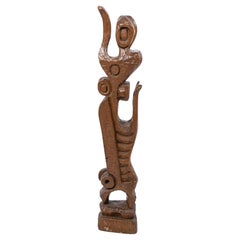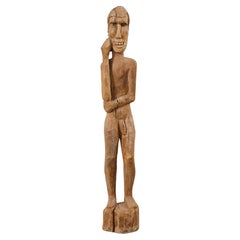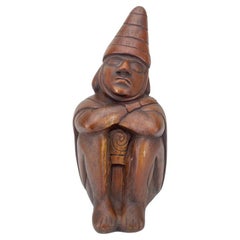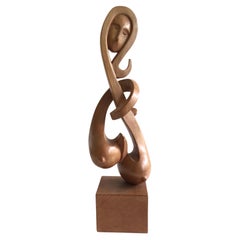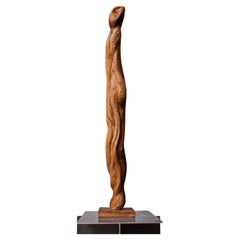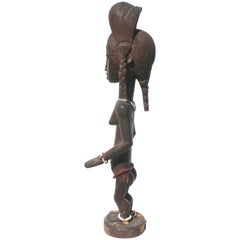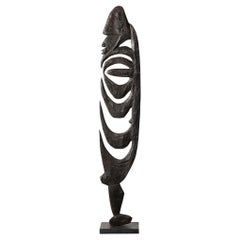Wood Carved Figural Sculpture
to
88
518
195
360
219
144
137
107
72
61
52
37
24
23
23
22
20
17
17
16
13
9
8
7
6
6
6
5
5
5
5
5
4
4
4
4
3
3
2
2
2
2
2
2
1
1
1
12
2
2
2
1
Sort By
Contemporary Carved Wood Figural Sculpture
Located in Queens, NY
Contemporary carved wood abstract figural sculpture.
Category
20th Century American Modern Figurative Sculptures
Tribal Style Carved Wood Standing Figure Sculpture
Located in Rio Vista, CA
. The carved figure is depicted standing on a wooden plinth with a curious expression. Hand-carved with
Category
20th Century Tribal Figurative Sculptures
Materials
Wood
Peruvian Figural Wood Carved Sculpture After Moche Stirrup Vessel, Dreamer
Located in Plainview, NY
Peruvian Figural Wood Carved Sculpture After Moche Stirrup Vessel, Dreamer: A stirrup vessel
Category
20th Century Tribal Abstract Sculptures
Materials
Wood
$425
H 10 in W 9 in D 4.5 in
1960s Carved Wood Sculpture of Woman Figure Mounted on Wood Pedestal
Located in Tarrytown, NY
11960s Carved Wood Sculpture of Woman Figure Mounted on Wood Pedestal
Woman with breasts
Mounted on
Category
Vintage 1960s Figurative Sculptures
Materials
Wood
Italian master - 18th century figure sculpture - Virgin Pity - Carved Wood Paint
Located in Varmo, IT
Carved and painted wooden sculpture - Pietà - Italy, 18th century.
13 x 7 x h 22.5 cm.
Entirely
Category
Mid-18th Century Old Masters Figurative Sculptures
Materials
Wood, Paint
$834 Sale Price
22% Off
H 5.12 in W 2.76 in D 8.86 in
Brutalist / Wabi Sabi Midcentury Hand Carved Wood Figure Sculpture, 1970s
Located in AMSTERDAM, NL
An amorphous and free form sculpture by an unknown artist. Carved from one piece of natural wood
Category
Vintage 1970s Belgian Brutalist Abstract Sculptures
Materials
Wood
$1,620
H 17.33 in W 6.7 in D 3.94 in
Brutalist Midcentury Hand Carved Wood Figure Sculpture, 1970s, Giacometti style
Located in AMSTERDAM, NL
This wooden sculpture, crafted circa 1965, captures the fluidity and elegance of the human form
Category
Vintage 1970s Belgian Brutalist Abstract Sculptures
Materials
Wood
$1,215
H 23.63 in W 3.94 in D 3.94 in
Baule Female Carved Wood Figure, African Sculpture Sotheby's Provenance
By Baule Tribe
Located in Sharon, CT
A fine Baule female figure. Provenance: The Alexander S. Honig collection of African Art, May 18
Category
Early 20th Century Ivorian Tribal Figurative Sculptures
Materials
Wood
$7,500
H 19.25 in W 3.75 in D 4.5 in
Male Yipwon Figural Carved Wood Sculpture on Stone Base
Located in New York, NY
This striking Yipwon sculpture is a powerful testament to the artistic and spiritual traditions of
Category
20th Century Papua New Guinean Mid-Century Modern Animal Sculptures
Materials
Stone
Carved Ebony Root Wood Figural Dancer Mounted Sculpture
Located in North Miami, FL
Alexandre Noll style abstract female nude figural sculpture mounted on Lucite square base
Category
Vintage 1980s French Mid-Century Modern Figurative Sculptures
Materials
Acrylic, Ebony
Mid-Century Modern Abstract Figure Carved Wood Table Sculpture
Located in Chula Vista, CA
Mid-Century Modern abstract figure carved wood table sculpture
unmarked
Measures: 5.5 tall x 4.5
Category
Late 20th Century Mid-Century Modern Abstract Sculptures
Materials
Wood
Vintage Carved Wood Articulated Clown Figure
Located in Santa Monica, CA
Chunky hand carving with simple facial detailing a pointed hat. Found in the southern US. Presented on a custom museum stand.
Category
Vintage 1930s American Folk Art Sculptures
Materials
Wood
20th Century Figural Carved Solid Wood Resting Camel Sculpture Distressed White
Located in Topeka, KS
Marvelous 20th Century vintage figural carved solid wood resting camel sculpture with a distressed
Category
20th Century Unknown Other Animal Sculptures
Materials
Wood, Paint
$1,795
H 17.25 in W 32.25 in D 9 in
Antique Polychromed Carved Wood Religious Spanish Priest 18" Sculpture Figure
Located in Philadelphia, PA
Antique Polychromed Carved Wood Religious Spanish Priest 18" Sculpture Figure. Circa Late 19th
Category
Antique Late 19th Century Unknown Renaissance Revival Figurative Sculptures
Materials
Wood
$950
H 17.5 in W 9 in D 5 in
18thc French Large Carved Wood Putto/ Angel Figural Sculpture
Located in Opa Locka, FL
On offer an 18thc Large Beautiful French Wood Sculpture of a Putto/ Angel Figure. There are losses
Category
Antique 1780s French Baroque Wall-mounted Sculptures
Materials
Wood
$2,840 Sale Price
20% Off
H 22.5 in W 7 in D 5 in
Original Carved Wood Sculpture Female Figure Hand Painted Carole Harrison
Located in Toledo, OH
Original hand painted carved wood female figure sculpture by Michigan artist Carole Harrison
Category
Vintage 1980s North American Modern Figurative Sculptures
Materials
Wood
$695
H 18 in W 11.25 in D 3.5 in
Hand Carved Wood Figural Bull Statue
Located in Cincinnati, OH
This skillfully executed hand carved figural bull is fully dimensional and has a rich brown color
Category
Early 20th Century Unknown Folk Art Animal Sculptures
Materials
Wood
Chinese Polychrome Wooden Carved Wood 28" Tang Horse Sculpture Statue Figure
Located in Philadelphia, PA
Chinese Polychrome Wooden Carved Wood 28" Tang Horse Sculpture Statue Figure. Item features solid
Category
Late 20th Century Unknown Chinoiserie Animal Sculptures
Materials
Wood
$1,350
H 24 in W 28 in D 9 in
Oceanic Islands Carved Wood Male Figure
Located in Rochester, NY
Oceanic islands carved hardwood standing male figure w/ finely detailed anatomical features and
Category
20th Century Unknown Tribal Figurative Sculptures
Materials
Iron
"Dolpo Shamanic Figure, " Carved Wood created circa 1900
Located in Milwaukee, WI
This shamanic figure was created by the Nepalese Dolpo people. It depicts a figure with arms in a
Category
Early 1900s Folk Art Figurative Sculptures
Materials
Wood
$1,900
H 10.5 in W 2 in D 1.75 in
Vintage Burmese Carved Wood Oriental Large Figural Statue Sculpture on Base
Located in Philadelphia, PA
Vintage Burmese Carved Wood Oriental Large Figural Statue Sculpture on Base Item features a solid
Category
Mid-20th Century Figurative Sculptures
Materials
Wood
$7,500
H 69 in W 29.5 in D 15.5 in
Antique Chinese Carved Wood Standing Sculpture of Quan Yin Figure, Circa 1890's.
Located in New Orleans, LA
Antique Chinese Carved Wood Standing Sculpture of Quan Yin Figure, Circa 1890's.
The figure of the
Category
Antique Late 19th Century Chinese Figurative Sculptures
Materials
Wood
$8,500
H 55.5 in W 19 in D 12 in
"Dolpo Shamanic Figure, " Carved Wood created circa 1900
Located in Milwaukee, WI
This shamanic figure was created by the Nepalese Dolpo people. It depicts a man with arms at his
Category
Early 1900s Other Art Style Figurative Sculptures
Materials
Wood
$1,900
H 11.5 in W 2.25 in D 1.5 in
"Ekamka Fetish - Nigeria, " Carved Wood Figure created circa 1910
Located in Milwaukee, WI
This Ekamka Fetish sculpture was carved from wood by an unknown Nigerian artist. It depicts a
Category
1910s Folk Art Figurative Sculptures
Materials
Wood
$3,250
H 24.5 in W 6.5 in D 6.5 in
Carved Wood Seated Figure in Jeweled Clothing
Located in Pasadena, TX
This sculpture is carved from a single piece of wood. The wood is very richly grained. It's hand
Category
20th Century Asian Figurative Sculptures
Materials
Wood, Paint
Carved Wood Falcon Sculpture 1960s
Located in North Hollywood, CA
falcon sculpture.
Carved wood figure of an Eagle sculpture from the 1960s. Eagle figure perched on a
Category
Mid-20th Century Mexican Folk Art Animal Sculptures
Materials
Wood
1960's J.G Casas Modernist Abstract Figural Wood Carved Sculpture Mexican Artist
By Don S. Shoemaker
Located in San Diego, CA
We are offering a wonderful hand carved wood figural sculpture by Mexican artist, J.G. Casas, circa
Category
Mid-20th Century Mexican Abstract Sculptures
Materials
Wood
$750
H 18.25 in W 7.25 in D 4.25 in
Chinese Polychrome Wooden Carved Wood 29" Tang Horse Sculpture Statue Red Figure
Located in Philadelphia, PA
Chinese Polychrome Wooden Carved Wood 29" Tang Horse Sculpture Statue Red Figure. Item features
Category
Late 20th Century Unknown Chinoiserie Animal Sculptures
Materials
Wood
$1,450
H 28 in W 18 in D 13 in
Chinese Polychrome Wooden Carved Wood Tang Style 31" Gold Horse Sculpture Figure
Located in Philadelphia, PA
Chinese Polychrome Wooden Carved Wood Tang Style 31" Gold Horse Sculpture Figure. Circa Late 20th
Category
Late 20th Century Unknown Chinoiserie Animal Sculptures
Materials
Wood
$1,350
H 24 in W 31 in D 8.5 in
David Hostetler Carved Lacewood Sculpture Beige Female Full Figure Figurative
By David Hostetler
Located in Nantucket, MA
A stunning figure carved from a single section of lacewood. Natural color finish. The base is a 2
Category
2010s Abstract Figurative Sculptures
Materials
Wood
18th Century, Spanish Conquistador Carved Wood Figure
Located in Houston, TX
18th century Spanish Conquistador carved wood figure.
18th century Carved and painted wood Spanish
Category
Antique 18th Century Spanish Baroque Figurative Sculptures
Materials
Wood
Primitive Carved Wood Figural Tiki Totem Kinetic Wobbly Balancing Art Sculpture
Located in Philadelphia, PA
Vintage Primitive Carved Wood Figural Tiki Kinetic Wobbly Balancing Art Sculpture. Circa Late 20th
Category
Late 20th Century Unknown Folk Art Sculptures and Carvings
Materials
Wood
$850
H 42 in W 24 in D 7 in
Vintage African Carved Wood Figure of a Large Hornbill Bird Sculpture Large
Located in Rochester, NY
A 20th Century reproduction carved sculpture depicting a standing bird, supported on a domed base
Category
20th Century African Bohemian Animal Sculptures
Materials
Wood
$3,250
H 65 in W 17 in D 19.25 in
Oceanic Carved Wood Figure Of Two Lovers
Located in Germantown, MD
Oceanic Carved Wood Figure Of Two Lovers 43" tall.
Category
Mid-20th Century Unknown Mid-Century Modern Figurative Sculptures
Materials
Hardwood
18th Baroque Sculpture of an Allegorical Female Figure in Carved and Gilded Wood
Located in Marbella, ES
A refined Baroque sculpture carved in wood and gilded with gold leaf, depicting an allegorical
Category
Antique 18th Century Spanish Figurative Sculptures
Materials
Wood
$3,574
H 12.21 in W 9.85 in D 7.49 in
Early Carved Wood And Polychrome Religious Figure
Located in Bradenton, FL
Beautifully carved religious figure, of solid wood painted in colors of red, brown and green
Category
Antique 19th Century Spanish Spanish Colonial Figurative Sculptures
Materials
Wood
Roger Francois ( Haitian, 1928-2013) Wood Figural Sculpture
By Roger Francois
Located in Bridgeport, CT
A tall and arresting Hand-Carved wood Sculpture of of an inverted woman. Strongly carved with only
Category
20th Century Haitian Tribal Figurative Sculptures
Materials
Wood
20th Century Art Deco Carved-Wood Figure
Located in Southall, GB
Art Deco carved-wood figure of a lady with her arms stretched out in gold and silver gilt.
Category
20th Century Figurative Sculptures
Materials
Wood
Female Nude Figure Bust Wood Carving 1960s sculpture
Located in Gravesend, GB
Excellent Classic Carving of Female Nude Pose
Incredible detail, great scale.
Unsigned.
From around 1960s
Category
Vintage 1960s European Figurative Sculptures
Materials
Wood
Folk Art 20th Century Carved Wood Figure Sculpture of Saint Florian Austria 1960
Located in Nuernberg, DE
Pine carving of Saint Florian, the patron saint of fire fighters, 20th century Austria, the saint shown holding his cape in one hand, pouring a bucket of water over a burning buildin...
Category
Vintage 1960s Austrian Black Forest Sculptures and Carvings
Materials
Wood
$580
H 17 in W 6 in D 4 in
"Wooden Figure, " Carved Wood created in Indonesia during the 19th Century
Located in Milwaukee, WI
This wooden figure was created by an unknown Indonesian artist and features a dark-skinned man with
Category
19th Century Folk Art Figurative Sculptures
Materials
Wood
$1,300
H 17.5 in W 5.5 in
Early 17th Century Carved Wood Figure of Guanyin
Located in Gloucestershire, GB
17th Century carved figure of Guanyin in Rajalalitasana position.
Seated on rock with the right
Category
Antique 17th Century Chinese Figurative Sculptures
Materials
Wood
Antique Korean Carved Polychrome Wooden Buddhist Figure Sculpture
Located in Forney, TX
this large Joseon dynasty (1392–1910) antique Asian hand carved and painted wood Buddhist figure
Category
Antique 19th Century Korean Folk Art Sculptures and Carvings
Materials
Wood
18th century Antique Wood-carved Santo figure in later Tabernacle
Located in Leesburg, VA
18th century Antique Wood-carved Santo figure in later Tabernacle
Anonymous
Spain or Spanish
Category
Antique Mid-18th Century Spanish Spanish Colonial Figurative Sculptures
Materials
Wood, Oak
$3,295
H 29.5 in W 14.5 in D 12.5 in
Antique Moroccan Carved Polychrome Painted Wooden Camel Figure Sculpture
Located in Forney, TX
African Art Deco Orientalist figural carving features fine detailing throughout, hand carved, sculpted and
Category
Early 20th Century Moroccan Art Deco Animal Sculptures
Materials
Wood, Paint
$3,500
H 11 in W 14 in D 4.25 in
1870s English Carved Wood Robin Hood Figure
Located in Tarrytown, NY
1870s English carved wood Robin Hood figure.
Category
Antique 1870s Sculptures and Carvings
Materials
Wood
Extremely Fine Northern European Carved Wood and Polychrome Decorated Figure
Located in North Miami, FL
indicative commonalities of high Baroque sculptures from Austria and Germany in the late 17th and early 18th
Category
Antique 17th Century German Baroque Figurative Sculptures
Materials
Gold Leaf
$10,760 Sale Price
20% Off
H 31 in W 25 in D 11 in
French Egyptian Revival Carved Wood Figure of King Tutankamun
Located in Stamford, CT
A carved standing figure of King Tutankamun wearing the royal headdress topped by the double uraeus
Category
Early 20th Century French Egyptian Revival Figurative Sculptures
Materials
Wood
Italian Carved Wood Figural Card Stand, Receiver, Late 18th Century
Located in Manhasset, NY
Antique Italian carved wood figural card stand or server. Life-sized figure in the form of a young
Category
Antique Mid-19th Century Rococo Figurative Sculptures
Materials
Wood
$10,200
H 63.5 in W 16 in D 11.5 in
Antique Polychromed Carved Wood Buddha Figure 20th C
Located in Big Flats, NY
An antique Chinese figure offers polychromed carved wood carving of a standing Buddha, 20th century
Category
20th Century Chinese Sculptures and Carvings
Materials
Wood
$960 Sale Price
20% Off
H 29 in W 7.25 in D 6.5 in
Vintage Carved Wood Thai Buddha Figure Kneeling and Praying
Located in North Hollywood, CA
Vintage Wood Carving Art Thai Buddha Figure kneeling and praying.
Vintage Mid century wood carving
Category
Mid-20th Century Thai Folk Art Sculptures and Carvings
Materials
Wood
105" Tall Hand Carved Figural Wood Spirit Animals Tree Trunk Totem Sculpture
Located in Chattanooga, TN
and inspiring. This traditional style folk art is carved with the artists initial "WD" and date "95
Category
Late 20th Century American Folk Art Sculptures and Carvings
Materials
Hardwood
$5,895
H 105 in W 33.5 in D 25 in
African Mumuye Carved Wood Iagalagana Tutelary Figure on Display Stand
Located in Studio City, CA
A carved wood Iagalagana figure by the Mumuye Peoples of Nigeria. These figures served as guardians
Category
Early 20th Century Nigerian Figurative Sculptures
Materials
Wood
$2,495
H 39.5 in W 7.5 in D 7 in
Idoma Ido Nigerian Carved Wood Figure Of A Seated Female
Located in Dallas, TX
Idoma Ibo Female Figure. Africa, Nigeria 20th century or earlier.
A seated female figure on a
Category
Antique Early 1900s Nigerian Primitive Figurative Sculptures
Materials
Wood
Set of Three Hand Carved Figural African Polychromed Colonial Style Sculptures
Located in San Diego, CA
Set of three hand carved figural African polychromed colonial style sculptures, circa 1970s. The
Category
Mid-20th Century African Figurative Sculptures
Materials
Wood
$380 Sale Price / set
20% Off
H 13 in W 3 in D 3 in
Vintage Tribal Figural Sculpture
Located in Queens, NY
Vintage carved figure of a male dancer with cross hatched ear design
Category
20th Century Unknown Tribal Figurative Sculptures
Materials
Wood
Late 19th Century Live Size Renaissance Revival Italian Figural Carved Sculpture
Located in Chicago, IL
This late 19th-century carved wooden sculpture is a lifesize depiction of a young nobleman of the
Category
Antique Late 19th Century Italian Renaissance Revival Figurative Sculptures
Materials
Plaster, Wood
$6,950
H 94 in W 25 in D 23 in
Burmese Mandalay carved wood figure of the standing Buddha
Located in Point Richmond, CA
Burmese Mandalay carved wood figure of the standing Buddha on a square base, the left hand is in
Category
Early 20th Century Burmese Other Sculptures and Carvings
Materials
Hardwood
- 1
- ...
Get Updated with New Arrivals
Save "Wood Carved Figural Sculpture", and we’ll notify you when there are new listings in this category.
Wood Carved Figural Sculpture For Sale on 1stDibs
Choose from an assortment of styles, material and more in our collection of wood carved figural sculpture on 1stDibs. Was constructed with extraordinary care, often using wood, paint and metal. Whether you’re looking for newer or older items, there are earlier versions available from the 18th Century and newer variations made as recently as the 21st Century. Each piece of wood carved figural sculpture bearing Folk Art, Baroque or Mid-Century Modern hallmarks is very popular. Interi, Baule Tribe and Brian Stanziale each produced at least one beautiful item from our selection of wood carved figural sculpture that is worth considering.
How Much is a Wood Carved Figural Sculpture?
Prices for a piece of wood carved figural sculpture can differ depending upon size, time period and other attributes — at 1stDibs, they begin at $150 and can go as high as $156,000, while the average can fetch as much as $1,689.
Questions About Wood Carved Figural Sculpture
- 1stDibs ExpertOctober 19, 2021The difference between carving and sculpture is that carving is a carved object, whereas sculpture is the art of shaping figures or designs — because sculpture can involve adding material (i.e., working with plaster, creating a mold to be cast in bronze), it is considered “additive” versus the “subtractive” act of carving.
- 1stDibs ExpertApril 5, 2022Carved African wood figurines were typically spiritual in nature and were primarily in human form. The wood figurines were carved using ebony, teak, mahogany and iron wood. On 1stDibs, find a collection of authentic African wood figurines from some of the world’s top sellers.
More Ways To Browse
Poncho Brown
Mandalay Wood Figure
Prop Statue
Spanish Conquistador
Angel Buddha
Antique German Gnomes
Carved Nativity
Carved Wood Nativity
Falcon Eye
Religious Figurines Italian
Black Forest Gnome
Female Buddha Statues
Kneeling Buddha
Peacock Burma
Spanish Colonial Reliquary
Antique Nut Cracker
Petrified Wood Arizona
Thai Figurines
